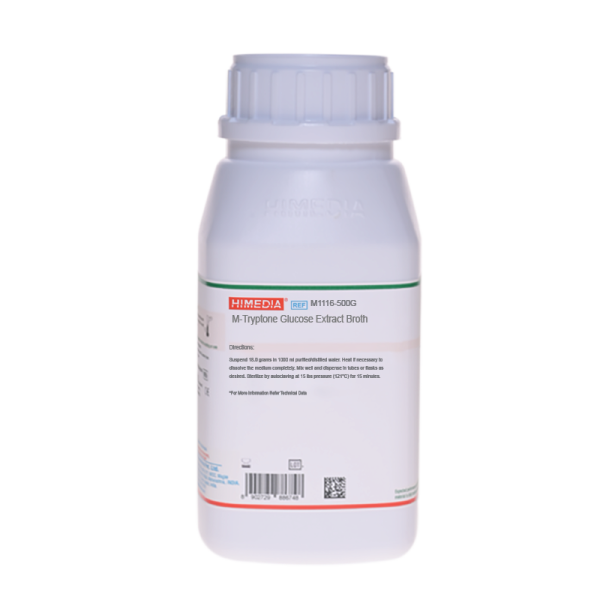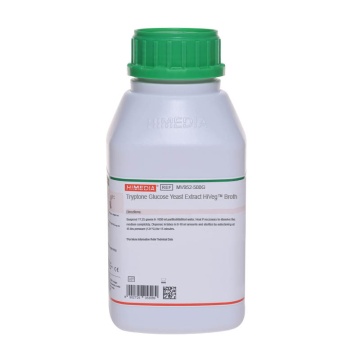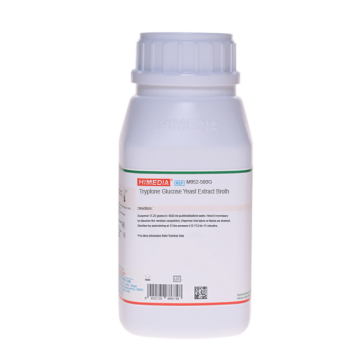 Your enquiry has been submitted
Your enquiry has been submitted
M-Tryptone Glucose Extract Broth
Intended Use
Recommended for determination of bacterial count in milk and other samples in dairy sanitization by membrane filter technique.
Composition
| Ingredients | g/L |
|---|---|
| Tryptone | 10.000 |
| HM peptone B # | 2.000 |
| Dextrose (Glucose) | 6.000 |
| Final pH (at 25°C) | 7.0±0.2 |
**Formula adjusted, standardized to suit performance parameters
# Equivalent to Beef extract
Directions
Suspend 18.0 grams in 1000 ml purified/distilled water. Heat if necessary to dissolve the medium completely. Mix well and dispense in tubes or flasks as desired. Sterilize by autoclaving at 15 lbs pressure (121°C) for 15 minutes.
Principle And Interpretation
The dairy industry has relied for safety on control of the manufacturing process and on the use of tests such as the standard plate count and coliform count as indicators of post process contamination. Testing of dairy products or dairy plant environment samples for pathogens has not been routinely performed. However, there is a need for at least surveillance testing of product and environmental samples as well as for re-evaluation of processing and environmental control procedures. Evaluation of this may require that product and environmental samples be analyzed for pathogens (1). M-Tryptone Glucose Extract Broth is used as non-selective general purpose media recommended by APHA (2) for determination of bacterial counts in dairy products and water (2), foods (3) and other specimens respectively. Tryptone and HM peptone B provide the essential nutrients like amino acids, minerals and trace growth factors. Dextrose serves as the carbon source. About 2 ml of the broth medium is used to saturate sterile absorbent pads. Filters used for membrane filtration are then aseptically placed on these absorbent pads.
Type of specimen
Food and dairy samples; Water samples
Specimen Collection and Handling
For food and dairy samples, follow appropriate techniques for sample collection and processing as per guidelines (1,3). For water samples, follow appropriate techniques for sample collection, processing as per guidelines and local standards.(2)
After use, contaminated materials must be sterilized by autoclaving before discarding.
Warning and Precautions :
Read the label before opening the container. Wear protective gloves/protective clothing/eye protection/face protection. Follow good microbiological lab practices while handling specimens and culture. Standard precautions as per established guidelines should be followed while handling specimens. Safety guidelines may be referred in individual safety data sheets.
Limitations :
- Further biochemical and serological tests must be carried out for further identification.
Performance and Evaluation
Performance of the medium is expected when used as per the direction on the label within the expiry period when stored at recommended temperature.
Quality Control
Appearance: Cream to yellow homogeneous free flowing powder
Colour and Clarity of prepared medium: Light amber coloured clear solution without any precipitate
Reaction: Reaction of 1.8% w/v aqueous solution at 25°C. pH: 7.0±0.2
pH: 6.80-7.20
Cultural Response: Cultural characteristics observed after an incubation at 35-37°C for 18-24 hours.
| Organism | Inoculum (CFU) | Growth |
|---|---|---|
| Escherichia coli ATCC 25922 (00013*) | 50-100 | luxuriant |
| Salmonella Typhi ATCC 6539 | 50-100 | luxuriant |
| Staphylococcus aureus subsp. aureus ATCC 25923 (00034*) | 50-100 | luxuriant |
Key: *Corresponding WDCM numbers.
Storage and Shelf Life
Store between 10-30°C in a tightly closed container and the prepared medium at 15-25°C. Use before expiry date on the label. On opening, product should be properly stored dry, after tightly capping the bottle in order to prevent lump formation due to the hygroscopic nature of the product. Improper storage of the product may lead to lump formation. Store in dry ventilated area protected from extremes of temperature and sources of ignition. Seal the container tightly after use. Product performance is best if used within stated expiry period.
Disposal
User must ensure safe disposal by autoclaving and/or incineration of used or unusable preparations of this product. Follow established laboratory procedures in disposing of infectious materials and material that comes into contact with sample must be decontaminated and disposed of in accordance with with current laboratory techniques (4,5).
Reference
- Wehr H. M. and Frank J. H., 2004, Standard Methods for the Microbiological Examination of Dairy Products, 17th Ed., APHA Inc., Washington, D.C.
- Greenberg A. E., Trussell R. R. and Clesceri L. S. (Eds.), 1985, Standard Methods for the Examination of Water and Wastewater, 16th Ed., APHA, Washington, D.C.
- Salfinger Y., and Tortorello M.L., 2015, Compendium of Methods for the Microbiological Examination of Foods, 5th Ed., American Public Health Association, Washington, D.C.
- Isenberg, H.D. Clinical Microbiology Procedures Handbook 2nd Edition.
- Jorgensen, J.H., Pfaller, M.A., Carroll, K.C., Funke, G., Landry, M.L., Richter, S.S and Warnock., D.W. (2015) Manual of Clinical Microbiology, 11th Edition. Vol. 1.
| Product Name | M-Tryptone Glucose Extract Broth |
|---|---|
| SKU | M1116 |
| Product Type | Regular |
| Physical Form | Powder |
| Origin | Animal |
| Packaging type | HDPE |
| References | 1.American Public Health Association, 1960, Standard Methods for the Examination of Water and Wastewater, 11th Ed.,APHA, New York.2.Greenberg A. E., Trussell R. R. and Clesceri L. S. (Eds.), 1985, Standard Methods for the Examination of Water andWastewater, 16th Ed., APHA, Washington, D.C.3.Speck M. L., (Ed.), 1984, Compendium of Methods for the Microbiological Examination of Foods, 2nd Ed., APHA,Washington, D.C.4.American Public Health Association, 1992, Standard Methods for the Examination of the Dairy Products, 16th Ed., APHA,Washington, D.C. |
| Customized Product Available | No |








